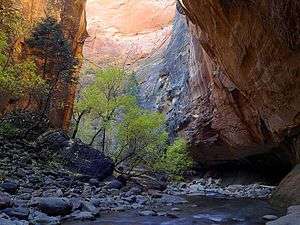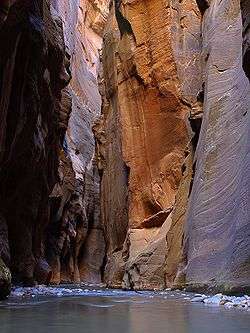The Narrows (Zion National Park)

The Narrows in Zion National Park, (near Springdale, Utah) is a section of canyon on the North Fork of the Virgin River. The hike of The Narrows is one of the premier hikes on the Colorado Plateau. The term The Narrows refers to both the through-hike of The Narrows, and to The Narrows themselves, especially the 3.6 miles (5.8 km) long section of canyon between the end of the Riverside Walk Trail and Big Spring. The Narrows lies north of, and upstream of, the main Zion Canyon. Hiking the Narrows was rated # 5 in the National Geographic ranking of America's Best 100 Adventures.[1]
History
Mormon Pioneer and Explorer Nephi Johnson was guided to Zion Canyon in November, 1858 by a friendly Paiute Indian, and was probably the first European-American to see The Narrows. Soon after, in 1861 and 1862, the towns of Virgin and Springdale, just south of Zion Canyon, were founded. The next year, Isaac Behunin built a cabin in upper Zion Canyon for summer farming.[2]
The Narrows was first descended (and named) in 1872 by geologist and explorer Grove Karl Gilbert as part of the Wheeler Survey. His party traveled from Navajo Lake through the Narrows to Zion Canyon and Springdale on horseback. John Wesley Powell had traversed the nearby Parunaweap Canyon (the East Fork of the Virgin) earlier in the same year.[3]
From when Zion became a National Park (1919), tourists were guided up the Narrows on horseback well into the 1960s. The through-hike of The Narrows became popular starting in the late 1960s.
Geography
The Virgin River runs south through upland aspen forest from near Navajo Lake at 9200 feet (2800 m) elevation, 11 miles (18 km) to Chamberlain's Ranch, 5900 feet (1800 m), where the through-hike of The Narrows starts. The river turns west and a gorge starts to form within 2 miles (3 km). By the time the North Fork enters Zion National Park, 5 miles (8 km) from Chamberlain's Ranch, the gorge is 500 feet (150 m) deep. Three and a half miles (6 km) further, at the confluence with Deep Creek, the gorge is 1300 feet (400 m) deep, and the combined river turns south. The gorge from here is continuous and has vertical sandstone walls from 40 to 100 feet (10 to 30 m) apart, with pockets of forest on both sides. From Deep Creek to Big Spring is 2.7 miles (4 km). At Big Spring, the canyon narrows again, and the true Narrows begin. For most of the next 3.6 mile (6 km) stretch to the Mouth of the Narrows, the river runs wall to wall, with vertical sandstone cliffs on both sides. A mile (2 km) south of the Mouth of the Narrows is the Temple of Sinawava, where the river enters main Zion Canyon, a flat-floored, quarter to half-mile (400 to 800 m) wide canyon with sandstone mountains on each side, their summits 2,400 feet (730 m) above. Eight miles (13 km) further south, where the canyon widens again, is the town of Springdale and the southern boundary of Zion National Park.
Hiking the narrows

The Narrows is one of the most unusual hikes on the Colorado Plateau. Hiking is done largely in the river as, for a third of the route, the river runs canyon wall to canyon wall. The walls are vertical and sheer, and often red in color. Water levels change from season to season; most hikers will wade at least waist-deep and many will swim a few short sections.
The Narrows can be hiked either as a through-hike from Chamberlain Ranch to the Temple of Sinawava; or as an up-and-back hike from the Temple of Sinawava. The through-hike can be done in a day or as a two-day backpack trip. Chamberlain's Ranch is accessed by the dirt North Fork Road east of the Park, and is situated in a rolling forest of aspen and scrub oak. No sign of the spectacular gorge ahead can be seen from the ranch. The hiker proceeds down the river and into an ever-deepening gorge, eventually getting to The Narrows and ending at the Temple of Sinawava. The hike is 16 miles (26 km) long and is very tiring because it is in the river itself. Permits are required before hiking the Narrows from the top and can be obtained at the Zion National Park Wilderness Desk. Reservations should be made ahead of time as permits can be difficult to get during the summer months.
The Narrows can be explored from the bottom up with most people finding Orderville Canyon an adequate destination. Visitors keep to the flood plain to avoid trampling fragile vegetation on the benches above the river. The farther one goes upstream, the less crowded the canyon becomes. Hiking in the river is strenuous. The water is often murky and the bottom of the river is covered with rocks about the size of bowling balls. This makes proper footwear and bringing in trekking poles or a walking stick essential. Several local suppliers in Springdale rent the tough rubber hiking shoes. The Narrows may be closed in the spring due to flooding while the snow melts off the upland areas to the north if the flow rate is higher than 120 cubic feet per second (3.4 m3/s). Thunderstorms can cause The Narrows to flash flood during the summer. Rain showers upriver can cause flash floods in the canyon without it raining over the canyon itself. Thus, hikers should exercise caution when hiking The Narrows during rainy periods as the winding canyon and sheer walls make approaching flash floods all the more sudden and difficult to evade.
References
- ↑ America's Best: Adventure 100
- ↑ Woodbury, Angus (July - October 1944, rev. 1950). A History of Southern Utah and Its National Parks. Salt Lake City, Utah, USA: Utah State Historical Society, Vol XII, Nos 3-4. Check date values in:
|date=(help) - ↑ Herbert, Gregory (1950). Geology and Geography of the Zion Park Region Utah and Arizona. Washington, DC, USA: US Department of the Interior, Geological Survey Professional Paper 220.
- A History of Southern Utah and Its National Parks, Angus M. Woodbury (Utah State Historical Society, Vol XII Nos. 3-4, July–October 1944; revised and reprinted, 1950 (No ISBN, no further publishing information available)).
- Brereton, Thomas; James Dunaway (1988). Exploring the Backcountry of Zion National Park: Off-Trail Routes (revised ed.). Springdale, UT: Zion Natural History Association. ISBN 0-915630-25-7.
- Gregory, Herbert E. (1950). Geology and Geography of the Zion Park Region Utah and Arizona. Washington DC: United States Department of the Interior, Geological Survey Professional Paper 220.
External links
Coordinates: 37°18′24″N 112°56′52″W / 37.30669°N 112.94769°W